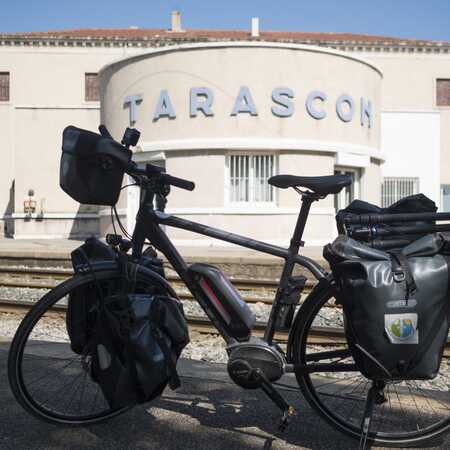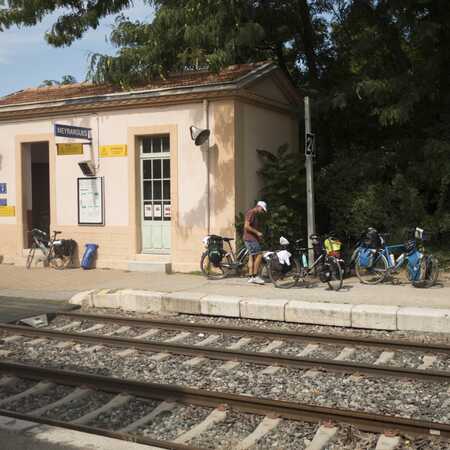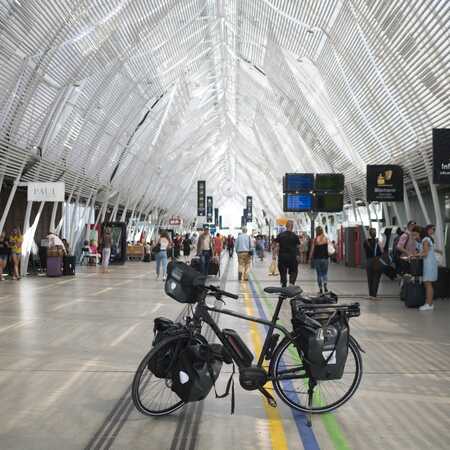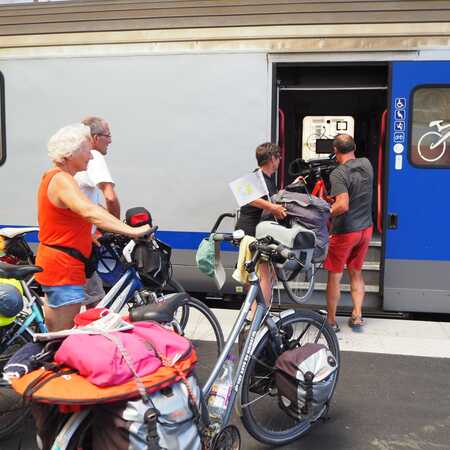Getting to and around the Méditerranée à Vélo
Whether coming by bike, on foot, in a car or in a coach, or by train, boat or plane, find all the practical information you need to get to the Méditerranée à Vélo cycle route easily.
Note that at time of writing, the links to Italy and Spain are not yet sufficiently well laid out for cyclists to continue along in comfort (except via the Pirinexus network spanning the Franco-Spanish Pyrenean border, but that is only suitable for mountain bikers). To come from Spain, the best advice is to get off at the Spanish train station of Figueres to climb across the Pyrenees to reach Le Perthus, the official southern starting point of our cycle route.
Coming from or going to Italy, we strongly advise that you avoid the Roya Valley and the Col de Tende pass, so terribly damaged by Storm Alex in 2020. Following this natural catastrophe, the valley’s railway line is still being reinforced at time of writing, so there is no direct train link that way. As the train line between Ventimiglia and Cuneo is also undergoing works at time of writing, the advice is to continue your journey towards San Remo and to follow routes that are in the process of being put in place up to Cuneo, to then continue across the Po plain. To plan your onward journey along the EuroVelo 8, head to the European website.
Joining our cycle route arriving by bike from another cycle route
The Méditerranée à Vélo crosses many other cycle routes along its length. Here is the list of main interconnections, if you wish to plan a circular route riding along cycle routes 100% of the time:
- ViaRhôna – shared section between Beaucaire and Sète
- Canal des Deux Mers à Vélo – shared section between Argeliers and Sète
- V81 (Pyrenean foothills) - connection at Le Barcarès
- V84 – connection at Béziers
- Pirinexus - connection at Le Boulou and Le Perthus
Our cycle route crosses the major French towns beside the Mediterranean:
As regards the towns of Narbonne, Béziers, Cannes and Nice, access by bike from the centre of these towns is possible to reach our cycle route.
Coming from Perpignan or Montpellier, here are the distances and times needed to ride over to our cycle route:
- Perpignan (Centre Médical des Berges de la Têt) to Sainte-Marie-la-Mer: 13.5km
- Montpellier St-Roch to Palavas les Flots: 13.7km
- Montpellier Gare Sud de France to Carnon: 10.6km
- Marseille and Avignon are not connected to our cycle route by safe separate cycle paths but lie close to points of entry for the route: Cavaillon and Tarascon from Avignon; and Meyrargues (near Aix-en-Provence) from Marseille.
You can also:
- Hire a bike from your starting point, from Perpignan, Narbonne, Montpellier, Avignon, Draguignan or Nice. Find the list of bike rental companies close to your starting point.
- Plan your trip with the help of the route calculator : bike-planner
Getting here by train + bike
There are many train stations located on or close to the cycle route, allowing you to get on and off the route easily, according to your various needs.
Before going further:
- Consult the section dedicated to Train + Vélo en France (Train + Bike in France).
- Go to the French railways SNCF website section dedicated to taking bikes on board trains.
Worth knowing:
- On French regional rail networks, transporting your bike by train is free. However, it is possible that you may be refused access to a train with your bike if there are too many passengers on board.
- Many high-speed TGV trains provide long-distance access to the cycle route, down the Rhône Valley, from Switzerland or even from Spain.
Tips for cyclists:
- On the Oui SNCF website, if you want to book a ticket including transportation of a bike that hasn’t been disassembled, for the time being, do not tick the box “vélo non démonté” (bike not disassembled), as TER regional trains, which DO accept the carriage of bikes that haven’t been disassembled (except during rush hours), will not show up in your search results…
- According to the blog Un monde à vélo: On certain high-speed TGV lines, it is sometimes possible to book online to carry a bike onboard in one direction (generally north-south) but not in the other direction. However, please note that spaces for bikes aboard all high-speed TGV trains CAN in fact be booked. If having problems with the website, phone French Railways or then go to a French train station to book the correct tickets.
Don’t be shy about asking for help on train + bike transportation!
Getting to the cycle route via high-speed TGV trains:
It is easy to reach the Méditerranée à Vélo by high-speed TGV trains with your bike folded or disassembled coming from the cities of Lyon, Grenoble, Chambéry, Toulouse, Geneva, Barcelona or Brussels.
- Sur le site Oui SNCF, si vous souhaitez réserver un billet avec transport d’un vélo non démonté, ne cochez pas la case “vélo non démonté” auquel cas les trains TER régionaux - qui acceptent les vélos non démontés à bord (hors heures de pointe) - n’apparaîtront pas dans les résultats …
- D’après le blog Un monde à vélo : Sur certaines lignes TGV, il est parfois possible de réserver en ligne une place pour le vélo dans un sens (souvent dans la direction nord-sud), mais pas dans l’autre. Cependant, il semblerait que ces emplacements vélo soient quand même réservables en gare ou par téléphone. N’hésitez pas à vous renseigner !
Getting to the cycle route via high-speed TGV trains:
It is easy to reach the Méditerranée à Vélo by high-speed TGV trains with your bike folded or disassembled coming from the cities of Lyon, Grenoble, Chambéry, Toulouse, Geneva, Barcelona or Brussels.
To read : how to bring your bike aboard french trains
- Only bikes that have been disassembled and placed in a carrying case measuring no more than 120cm x 90cm are allowed on most French trains for free. You don’t need to book, except on OUIGO trains, for which, at time of writing, you need to pay a €5 luggage supplement if you book a space for your disassembled, packed bike at the time you book your own ticket, or €10 if you add your disassembled and packed bike order at a later date.
- On certain high-speed TGV INOUI trains, it is possible to travel without taking your bike apart and to book a dedicated bike space in advance for €10 per bike.
- Bike carts are not accepted. Use panniers that are easy to detach.
Getting to the cycle route using French TER regional train services:
Here is a list of the main regional train stations serving the route: Perpignan, Toulouse, Narbonne, Béziers, Montpellier, Nîmes, Avignon, Lyon, Marseille, Tarascon, Cavaillon, Manosque, Draguignan, Cannes and Nice.
How to transport your bike in French trains?
Websites for buying tickets on French trains include a free ‘‘+ un vélo’’ (+ a bike) option in the search menu.
Then you can choose between opting for ‘‘un vélo non plié ou non démonté’’ (a bike that does not fold and isn’t disassembled) – not available in 1st class, however – or then ‘‘un vélo plié ou démonté rangé dans une housse’’ (a folding or disassembled bike in its carrying case).
Conditions for taking bikes on board trains do vary slightly from region to region, so check conditions:
Southern TER regional services : regional trains in Région Sud
Occitanie TER regional services : trains run by the LIO network
Auvergne TER Rhône-Alpes regional services : regional trains in Auvergne-Rhône-Alpes
Access to Intercités trains
The cycle route is accessible from Bordeaux, with the Intercités line Bordeaux – Marseille serving Narbonne, Béziers, Sète and Montpellier.
The Intercité night service Paris - Perpignan - Cerbère also enables cyclists to join the route, reducing considerably any possibility of problems concerning the transport of your bike.
On certain INTERCITÉS trains there are some spaces for bikes that can be booked in advance. When booking such a service, the option for a space for your bike (place vélo) is available from €5 up. Note that you must book in your bike at the same time as reserving your own train ticket.
Tips for cyclists: there are certain Intercités trains that you must book in advance. Also, when booking your ticket, make sure that the pictogram / icon of a bike appears, meaning you are allowed to take your bike on board. Note, though, that even with trains on which bikes are permitted, the number of spaces reserved for bikes is limited, so best arrive well in advance to make sure you get a space, as it is a first-come, first-served system. And try to avoid as far as possible rush hours on the busy lines.
Getting to our cycle route by coach + bike
To find coach companies that allow you to reach the route with your bike, don’t forget to download the access booklet.
In the Southern Region
Bikes can be carried in the hold, where you need to place them yourself, but note that only a limited number of bikes is permitted per coach. You can only book in advance for coaches provided by Lignes Express Régionales (LER). Where you’re carrying your bike in a bag, it’s then considered as a piece of luggage, for which transportation costs €6.50 in LER coaches.
Generally, bikes can be transported in the hold, but the total number that can be carried per coach is limited. At time of writing, only line 15, Avignon – Apt, is equipped with a bicycle rack, with up to eight spaces.
Consult the map of services for the Région Sud network.
Tips for cyclists: arrive well in advance and carry some elastic straps to help block the brakes.
In the Occitanie Region
The Région Occitanie is served by the liO coach network. It doesn’t give any specific details about the possibility of putting your bike in coach holds. However, the county of Hérault does specify that it limits the number of bikes to two that can be carried per coach with a raised floor. Low-floor coaches don’t have holds, so bikes cannot be carried on them.
From elsewhere in France and from abroad
Quite a number of private companies offer long-distance access by coach to most of the towns that our cycle route cross:
See online to find out about the possibilities for transporting bikes that haven’t been disassembled.
Getting to our cycle route by car
To tackle the Méditerranée à Vélo comfortably, driving to it with a car equipped with a bike rack is a practical, safe way of reaching your starting point with ease.
If coming from far away, the Méditerranée à Vélo can be reached relatively easy thanks to the good network of motorways leading to our regions.
Main motorways (autoroutes) going west to east:
- From Barcelona to Perpignan: A9
- From Bordeaux to Perpignan: A62, then A61
- From Toulouse to Narbonne: A61
- From Lyon to Montpellier: A7, then A9
- From Lyon to Cavaillon: A7
- From Aix - Marseille to Cavaillon: A7
- From Aix - Marseille to Manosque: A51
- From Aix - Marseille to Draguignan and Nice: A8
- From Toulon to Nice: A8
- From Grenoble to Nice: A7, then A8
Once you’ve reached the route by car, there are several possible options as to where to park your car:
- If heading out for a day’s cycling, opt for a car park close to the section of greenway you’re tackling (for example, a car park at a disused station), or then a street or car park in a town centre not far from the actual starting point of your ride along the route.
- If heading out for several days of cycling, a covered, paying car park is the best option. Find information on these from local tourist offices or town halls.
- A further practical option: if coming from far away, you might book a first night with an Accueil Vélo-accredited accommodation provider whom you might ask if they’d agree to your leaving your car with them for the duration of your cycling trip, in exchange for your spending a second night at their establishment at the end of your cycling adventure.
- If you go for an option where you’re leaving your car parked in a street or non-paying car park, it’s a good idea to ask the locals if the place is safe; and do not leave any items showing inside your car.
Getting to our cycle route by plane
Coming from abroad, you might join the Méditerranée à Vélo cycle route by plane.
How to plan flying with your bike?
It is possible to take a flight with your bike if it’s folded or disassembled and in a suitable carrying case.
Conditions for flying with your bike vary according to the airline you travel with (and according to the likes of weight, dimensions, booking fee, etc.)
Do consult the airline websites that might suit you.
→ Here, you can find out about the conditions for flying with your bike on Air France
Which airport to choose?
Here are the main airports close to our cycle route:
- Aéroport de Toulouse – Blagnac
- Aéroport Perpignan - Rivesaltes
- Aéroport Nîmes Alès Camargue Cévennes
- Aéroport Montpellier Méditerranée
- Aéroport Marseille Provence
- Nice Côte d’Azur
And then?
Once you’ve arrived at your chosen airport, you can join the cycle route either by train, coach or taxi, but make sure in advance that, whichever of these services you choose, your onward transport provider can take your bike(s) on board.



